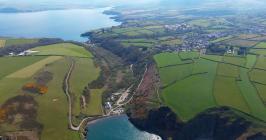Content can be downloaded for non-commercial purposes, such as for personal use or in educational resources.
For commercial purposes please contact the copyright holder directly.
Read more about the The Creative Archive Licence.
Description
Lede
The villagers of Cwm-yr-Eglwys lost their church in the same devastating 1859 storm that sank the Royal Charter.
Story
Between 25 and 26 October 1859, one of the strongest storms of the 19th century hit the Irish sea. Known as the ‘Royal Charter’ storm , the tempest was named after the ship Royal Charter which was caught on its way from Australia to Britain, carrying five hundred passengers and a huge amount of precious gold bullions. Following a brief stop in Queenstown (now Cobh) in Cork, the Royal Charter departed on 25 October 1859 for its final destination Liverpool. As the winds worsened, the ship anchored off the north coast of Anglesey to ride out the storm. But on the morning of 26 October 1859, the ship was smashed to pieces as strong winds pushed it onto the cliffs of Moelfre, a village on Anglesey's north-eastern coast. Around 450 persons on the Royal Charter died and the total loss of lives of the storm was around 800.
The villagers of Cwm-yr-Eglwys, a tiny fishing hamlet a few miles east of Fishguard, were ignorant of this impending nautical disaster when they gathered in their mediaeval church for the early evening service on October 25th 1859. They knew that stormy weather was building from the west that a high spring tide was lapping towards the top of the beach. Where once there had been two fields below the church and its surrounding graveyard, there was now only a short stretch of grass and it was not unknown for the lower part of the cemetery to be flooded. On two earlier occasions, the sea had actually broken into the church and in 1850 it had washed away the chancel – which had not been rebuilt.
In the late afternoon of this particular day the gale all of a sudden veered from westerly to nor’nor’easterly, with the high tide expected at 6.41pm.The village was now exposed to the full force of the gale. Three ships that had been sheltering in the lee of the nearby promontory were driven on the rocks; there was no possibility of rescuing their crews. The congregation in the church, many of belonging to sea going families, were doubtless praying for deliverance but at the height of the storm the tide, driven by the wind, surged through the east door and across the nave, bringing down the north and east walls of the building.
Miraculously, no one was lost or injured in the confusion and all the worshippers managed to escape via the west door. The graveyard however sustained the full force of the waves and was half washed away. Coffins were exposed or broken apart and some were seen bobbing on the water, with the corpses of the recent dead visible to their kinsfolk.
The storm did not abate until 6am next morning. One young mariner, who happened to be home from sea, took his grandfather’s boat out at first light and managed to retrieve several of the floating coffins, dragging them ashore by a rope tied to the handles. The drowned sailors’ bodies were washed in next day and the seven dead men were laid out in the ruined, roofless church.
All around the coast of North Pembrokeshire there was death and devastation following The Great Charter Storm. But nowhere was there such a disaster as at Cwm-yr-Eglwys. The church was beyond repair and a replacement was built on higher ground. Many of the traumatise inhabitants moved uphill and eventually created a new settlement closer to the turnpike road. Following repeated batterings that exposed more coffins, bodies and bones, the graveyard was provided with a stout retaining wall in 1882 and all the skeletal remains were interred in a communal grave behind it. This wall has had to be reinforced and repaired several times following storm damage, as recently in 1979 and 2007.
Today, the holiday makers who flock Cwm-yr-Eglwys (Valley of the Church) can see a model coastal vessel, made by a local blacksmith, beside the gate.
The remains of the ancient church (originally founded by the Irish Saint Brynach) still stands above the beach. On it turns a weathervane in the shape of a fish. Nowadays ,we don’t need that to know which way the wind blows. The Royal Charter Storm brought into being weather forecasting as we know it. The following year, 1860, saw the beginning of a system of storm warnings relayed by telegraph around the coast and in 1861 weather forecasts began to be printed in newspapers. But the villagers voted with their feet and never returned to Cwm-yr-Eglwys.
In 2009 a poet, Emyr Lewis, who knew the place from childhood holidays, wrote a short epitaph:
Gwylan haerllug a glaw yn arllwys,
cŵn, tai haf ac acenion Tafwys,
tonnau a beddau ar bwys, a chreigle;
mae rhyw wagle yng Nghwm-yr-Eglwys.
Impudent seagull and pouring rain,
Dogs, summer homes and Thames accents,
Waves and graves nearby and rocks,
There is an emptiness in Cwm-yr-Eglwys.
(Trans. Morys Rhys)





Do you have information to add to this item? Please leave a comment
Comments (0)
You must be logged in to leave a comment